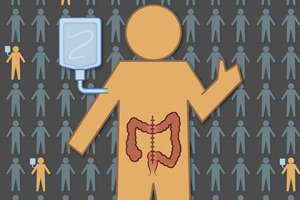NEJM: Colon cancer standard chemotherapy time is cut in half
Release date: 2018-04-04 Since 2004, oxaliplatin combined with fluoropyrimidine treatment for 6 months has become the standard adjuvant therapy for patients with stage III colon cancer. However, due to the strong correlation between oxaliplatin and cumulative neurotoxicity, scientists have been working to shorten the treatment time, and according to a recent trial, patients with stage III colon cancer, especially low-risk stage III patients, have been assisted. Chemotherapy time can be shortened to 3 months. DOI: DOI: 10.1056/NEJMoa1713709 The discovery was first published at the American Society of Clinical Oncology (ASCO) 2017 Annual Meeting and is now published in the New England Journal of Medicine on March 29. The author of the paper is Axel Grothey, MD, of the Mayo Clinic Cancer Center in Rochester, Minnesota. ASCO Chief Medical Officer Richard Schilsky said at the meeting that the results are changing practice. "I expect that starting next week, if patients have low-risk colon cancer, they will receive a shorter course of adjuvant chemotherapy." “The less is better!†ASCO expert Dr. Nancy Baxter commented at the time. “This is a great day for patients around the world. Today, up to 60% of my stage III colon cancer patients can continue to live after three months of treatment and have permanent problems (eg The chances of numbness in hands and feet are also low," she said. It is worth mentioning that, based on this study, the National Cancer Network's colon cancer guidelines have also been revised to show that patients with low-risk stage III colon cancer can be treated with shorter chemotherapy times. Image source: NEJM IDEA test Specifically, IDEA (International Adjuvant Therapy Duration Assessment) led by Dr. Axel Grothey collaborated on the results of six prospective studies involving 12,834 patients with stage III colon cancer. The team used FOLFOX (fluorouracil, leucovorin, and oxaliplatin) or CAPOX regimen (capecitabine and oxaliplatin) to perform a phase III clinical trial, which was designed for 3 months. treatment. The primary endpoint of the trial was 3 years of disease-free survival. If the upper limit of the 95% confidence interval (CI) on both sides of the hazard ratio (HR) does not exceed 1.12, then 3 months of treatment is noninferiority compared to 6 months. However, after reporting 3263 cases involving recurrence or death in the cohort, it was not possible to confirm non-inferiority of treatment for 3 months compared to 6 months in the total study population. The 3-year disease-free survival rate for the 3-month program was 74.6 %, and the 3-year disease-free survival rate for the 6-month program was 75.5 %. Non-inferiority was confirmed only in the subgroup However, scientists observed a non-inferiority of the 3-month regimen in a subgroup of patients treated with the CAPOX regimen (HR, 0.95; 95% confidence interval, 0.85 - 1.06). The 3-year disease-free survival rate for the 3-month program was 75.9 %, and the 3-year disease-free survival rate for the 6-month program was 74.8 %. However, in patients treated with FOLFOX, the scientists did not observe non-inferiority. In this subgroup, 6 months of adjuvant therapy was better than 3 months. The 3-year disease-free survival rate difference between the two groups was 2.4 percentage points (76.0% vs 73.6%). An exploratory analysis of a combination of low-risk patients (T1, T2, or T3 and N1 tumors) also found that the 3-month regimen was non-inferior to the 6-month regimen. The 3-year disease-free survival rate was 83.1% and 83.3%, respectively. For patients with high-risk T4 tumors, N2 tumors, or both tumors, the disease-free survival rate of the combined treatment for 6 months was better than 3 months (64.4% vs 62.7 %). In addition, trials have confirmed that regardless of the chemotherapy regimen used, the 3-month regimen is associated with a significant reduction in the incidence of adverse events. This is especially true for neurotoxicity at grade 2 or higher: the incidence of the 3-month treatment group (FOLFOX 16.6%, CAPOX 14.2%) was significantly lower than the 6-month treatment group (FOLFOX 47.7 %, CAPOX 44.9 %). The incidence of other adverse events (diarrhea, neutropenia, thrombocytopenia, nausea, mucositis, fatigue, and hand-foot syndrome, etc.) was also significantly reduced in the 3-month protocol. Precise labeling, efficient treatment Schilsky pointed out in a related editorial: "The problem with cancer-assisted chemotherapy is that for any patient, oncologists cannot easily determine the presence or absence of cancer or its response to treatment." “Even if (individual) tumors never recur, it is not possible to determine whether treatment is effective or unnecessary. Therefore, the most effective adjuvant chemotherapy regimen depends primarily on the multidimensional assessment of each patient's risk.†The results of this study will help guide oncologists and their patients to discuss complex issues associated with adjuvant therapy. To really optimize the use of this treatment, Schilsky stressed, “We need to do two things: first, find better markers to assess the risk of recurrence and the likelihood of benefit; second, find more effective, low Poison treatment plan." Reference: Excellent IDEA: Shorter Adjuvant Chemo in Colon Cancer Source: Biological exploration Small Safe,Smart Safe,Electronic Safe,Portable Safe Box Hebei Yingbo Safe Boxes Co.,Ltd , https://www.ybsafebox.com
